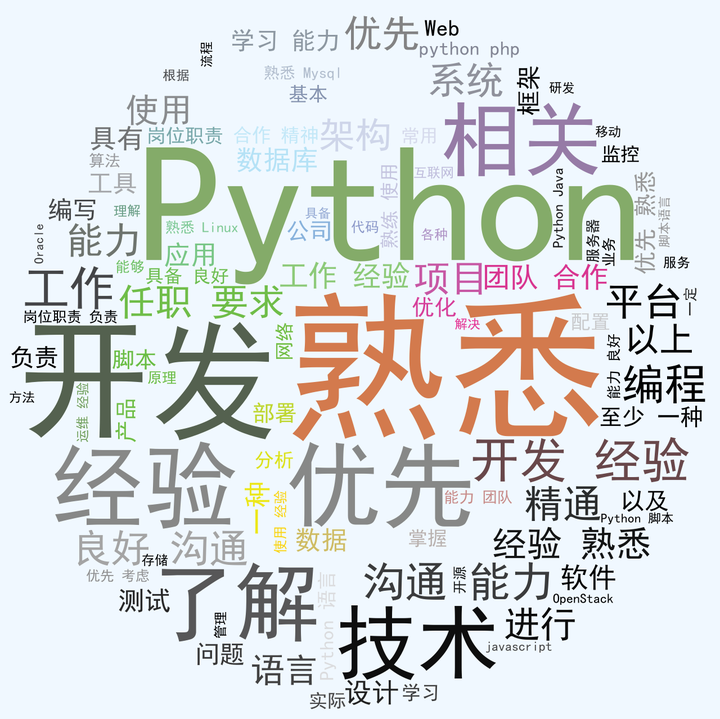前言
从智联招聘爬取相关信息后,我们关心的是如何对内容进行分析,获取用用的信息。
本次以上篇文章“5分钟掌握智联招聘网站爬取并保存到MongoDB数据库”中爬取的数据为基础,分析关键词为“python”的爬取数据的情况,获取包括全国python招聘数量Top10的城市列表以及其他相关信息。
一、主要分析步骤
- 数据读取
- 数据整理
- 对职位数量在全国主要城市的分布情况进行分析
- 对全国范围内的职位月薪情况进行分析
- 对该职位招聘岗位要求描述进行词云图分析,获取频率最高的关键字
- 选取两个城市,分别分析月薪分布情况以及招聘要求的词云图分析
二、具体分析过程
import pymongo
import pandas as pd
import matplotlib.pyplot as plt
import numpy as np
% matplotlib inline
plt.style.use('ggplot')
# 解决matplotlib显示中文问题
plt.rcParams['font.sans-serif'] = ['SimHei'] # 指定默认字体
plt.rcParams['axes.unicode_minus'] = False # 解决保存图像是负号'-'显示为方块的问题
1 读取数据
client = pymongo.MongoClient('localhost')
db = client['zhilian']
table = db['python']
columns = ['zwmc',
'gsmc',
'zwyx',
'gbsj',
'gzdd',
'fkl',
'brief',
'zw_link',
'_id',
'save_date']
# url_set = set([records['zw_link'] for records in table.find()])
# print(url_set)
df = pd.DataFrame([records for records in table.find()], columns=columns)
# columns_update = ['职位名称',
# '公司名称',
# '职位月薪',
# '公布时间',
# '工作地点',
# '反馈率',
# '招聘简介',
# '网页链接',
# '_id',
# '信息保存日期']
# df.columns = columns_update
print('总行数为:{}行'.format(df.shape[0]))
df.head(2)
欢迎加入我的QQ群`923414804`与我一起学习,群里有我学习过程中整理的大量学习资料。加群即可免费获取结果如图1所示:
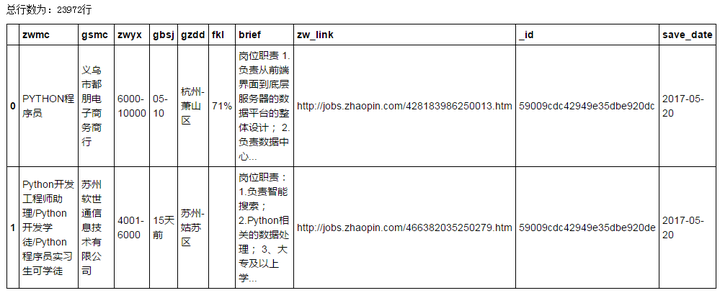
2 数据整理
2.1 将str格式的日期变为 datatime
df['save_date'] = pd.to_datetime(df['save_date'])
print(df['save_date'].dtype)
# df['save_date']
datetime64[ns]
2.2 筛选月薪格式为“XXXX-XXXX”的信息
df_clean = df[['zwmc',
'gsmc',
'zwyx',
'gbsj',
'gzdd',
'fkl',
'brief',
'zw_link',
'save_date']]
# 对月薪的数据进行筛选,选取格式为“XXXX-XXXX”的信息,方面后续分析
df_clean = df_clean[df_clean['zwyx'].str.contains('d+-d+', regex=True)]
print('总行数为:{}行'.format(df_clean.shape[0]))
# df_clean.head()
总行数为:22605行
2.3 分割月薪字段,分别获取月薪的下限值和上限值
# Pandas DataFrame, how do i split a column into two
# Append column to pandas dataframe
# df_temp.loc[: ,'zwyx_min'],df_temp.loc[: , 'zwyx_max'] = df_temp.loc[: , 'zwyx'].str.split('-',1).str #会有警告
s_min, s_max = df_clean.loc[: , 'zwyx'].str.split('-',1).str
df_min = pd.DataFrame(s_min)
df_min.columns = ['zwyx_min']
df_max = pd.DataFrame(s_max)
df_max.columns = ['zwyx_max']
df_clean_concat = pd.concat([df_clean, df_min, df_max], axis=1)
# df_clean['zwyx_min'].astype(int)
df_clean_concat['zwyx_min'] = pd.to_numeric(df_clean_concat['zwyx_min'])
df_clean_concat['zwyx_max'] = pd.to_numeric(df_clean_concat['zwyx_max'])
# print(df_clean['zwyx_min'].dtype)
print(df_clean_concat.dtypes)
df_clean_concat.head(2)
运行结果如图2所示:
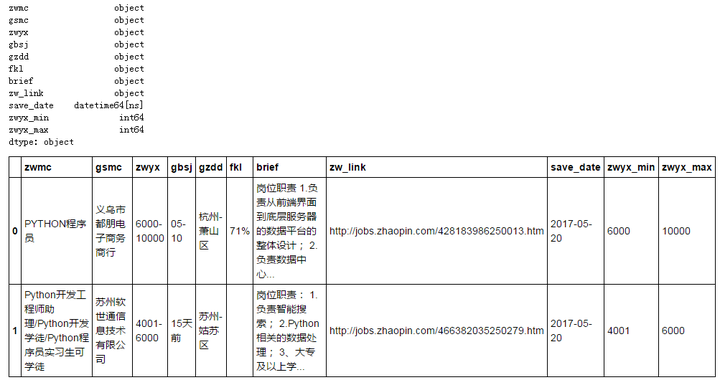
- 将数据信息按职位月薪进行排序
df_clean_concat.sort_values('zwyx_min',inplace=True)
# df_clean_concat.tail()
- 判断爬取的数据是否有重复值
# 判断爬取的数据是否有重复值
print(df_clean_concat[df_clean_concat.duplicated('zw_link')==True])
Empty DataFrame
Columns: [zwmc, gsmc, zwyx, gbsj, gzdd, fkl, brief, zw_link, save_date, zwyx_min, zwyx_max]
Index: []
- 从上述结果可看出,数据是没有重复的。
3 对全国范围内的职位进行分析
3.1 主要城市的招聘职位数量分布情况
# from IPython.core.display import display, HTML
ADDRESS = [ '北京', '上海', '广州', '深圳',
'天津', '武汉', '西安', '成都', '大连',
'长春', '沈阳', '南京', '济南', '青岛',
'杭州', '苏州', '无锡', '宁波', '重庆',
'郑州', '长沙', '福州', '厦门', '哈尔滨',
'石家庄', '合肥', '惠州', '太原', '昆明',
'烟台', '佛山', '南昌', '贵阳', '南宁']
df_city = df_clean_concat.copy()
# 由于工作地点的写上,比如北京,包含许多地址为北京-朝阳区等
# 可以用替换的方式进行整理,这里用pandas的replace()方法
for city in ADDRESS:
df_city['gzdd'] = df_city['gzdd'].replace([(city+'.*')],[city],regex=True)
# 针对全国主要城市进行分析
df_city_main = df_city[df_city['gzdd'].isin(ADDRESS)]
df_city_main_count = df_city_main.groupby('gzdd')['zwmc','gsmc'].count()
df_city_main_count['gsmc'] = df_city_main_count['gsmc']/(df_city_main_count['gsmc'].sum())
df_city_main_count.columns = ['number', 'percentage']
# 按职位数量进行排序
df_city_main_count.sort_values(by='number', ascending=False, inplace=True)
# 添加辅助列,标注城市和百分比,方面在后续绘图时使用
df_city_main_count['label']=df_city_main_count.index+ ' '+ ((df_city_main_count['percentage']*100).round()).astype('int').astype('str')+'%'
print(type(df_city_main_count))
# 职位数量最多的Top10城市的列表
print(df_city_main_count.head(10))
<class 'pandas.core.frame.DataFrame'>
number percentage label
gzdd
北京 6936 0.315948 北京 32%
上海 3213 0.146358 上海 15%
深圳 1908 0.086913 深圳 9%
成都 1290 0.058762 成都 6%
杭州 1174 0.053478 杭州 5%
广州 1167 0.053159 广州 5%
南京 826 0.037626 南京 4%
郑州 741 0.033754 郑州 3%
武汉 552 0.025145 武汉 3%
西安 473 0.021546 西安 2%
- 对结果进行绘图:
from matplotlib import cm
label = df_city_main_count['label']
sizes = df_city_main_count['number']
# 设置绘图区域大小
fig, axes = plt.subplots(figsize=(10,6),ncols=2)
ax1, ax2 = axes.ravel()
colors = cm.PiYG(np.arange(len(sizes))/len(sizes)) # colormaps: Paired, autumn, rainbow, gray,spring,Darks
# 由于城市数量太多,饼图中不显示labels和百分比
patches, texts = ax1.pie(sizes,labels=None, shadow=False, startangle=0, colors=colors)
ax1.axis('equal')
ax1.set_title('职位数量分布', loc='center')
# ax2 只显示图例(legend)
ax2.axis('off')
ax2.legend(patches, label, loc='center left', fontsize=9)
plt.savefig('job_distribute.jpg')
plt.show()
运行结果如下述饼图所示:
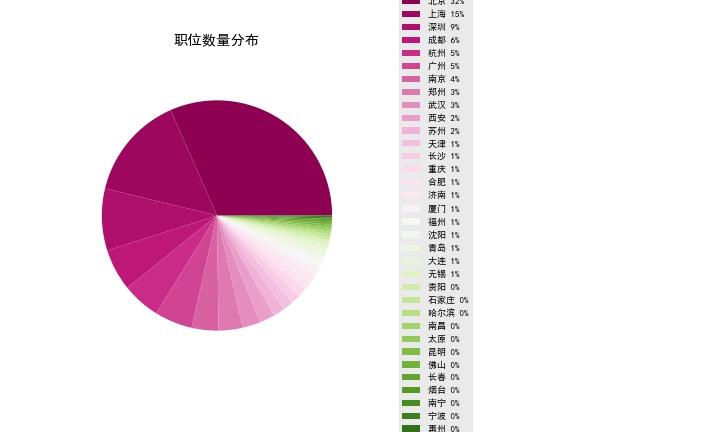
3.2 月薪分布情况(全国)
from matplotlib.ticker import FormatStrFormatter
fig, (ax1, ax2) = plt.subplots(figsize=(10,8), nrows=2)
x_pos = list(range(df_clean_concat.shape[0]))
y1 = df_clean_concat['zwyx_min']
ax1.plot(x_pos, y1)
ax1.set_title('Trend of min monthly salary in China', size=14)
ax1.set_xticklabels('')
ax1.set_ylabel('min monthly salary(RMB)')
bins = [3000,6000, 9000, 12000, 15000, 18000, 21000, 24000, 100000]
counts, bins, patches = ax2.hist(y1, bins, normed=1, histtype='bar', facecolor='g', rwidth=0.8)
ax2.set_title('Hist of min monthly salary in China', size=14)
ax2.set_yticklabels('')
# ax2.set_xlabel('min monthly salary(RMB)')
# Matplotlib - label each bin
ax2.set_xticks(bins) #将bins设置为xticks
ax2.set_xticklabels(bins, rotation=-90) # 设置为xticklabels的方向
# Label the raw counts and the percentages below the x-axis...
bin_centers = 0.5 * np.diff(bins) + bins[:-1]
for count, x in zip(counts, bin_centers):
# # Label the raw counts
# ax2.annotate(str(count), xy=(x, 0), xycoords=('data', 'axes fraction'),
# xytext=(0, -70), textcoords='offset points', va='top', ha='center', rotation=-90)
# Label the percentages
percent = '%0.0f%%' % (100 * float(count) / counts.sum())
ax2.annotate(percent, xy=(x, 0), xycoords=('data', 'axes fraction'),
xytext=(0, -40), textcoords='offset points', va='top', ha='center', rotation=-90, color='b', size=14)
fig.savefig('salary_quanguo_min.jpg')
运行结果如下述图所示:
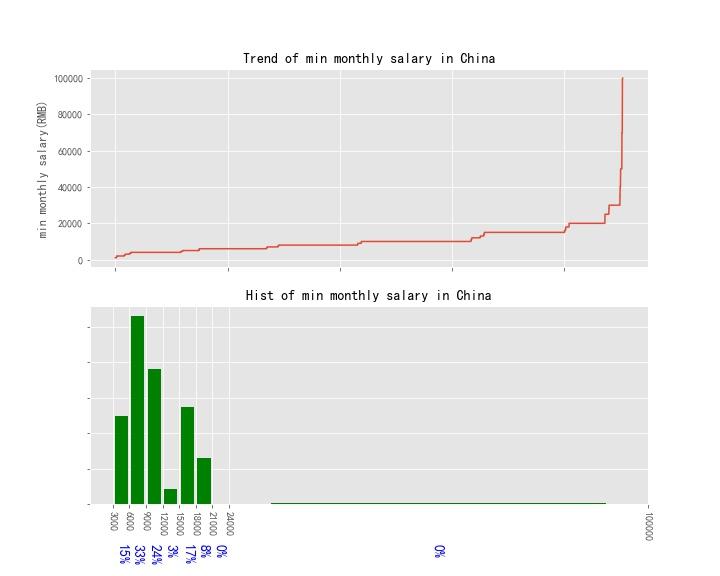
不考虑部分极值后,分析月薪分布情况
df_zwyx_adjust = df_clean_concat[df_clean_concat['zwyx_min']<=20000]
fig, (ax1, ax2) = plt.subplots(figsize=(10,8), nrows=2)
x_pos = list(range(df_zwyx_adjust.shape[0]))
y1 = df_zwyx_adjust['zwyx_min']
ax1.plot(x_pos, y1)
ax1.set_title('Trend of min monthly salary in China (adjust)', size=14)
ax1.set_xticklabels('')
ax1.set_ylabel('min monthly salary(RMB)')
bins = [3000,6000, 9000, 12000, 15000, 18000, 21000]
counts, bins, patches = ax2.hist(y1, bins, normed=1, histtype='bar', facecolor='g', rwidth=0.8)
ax2.set_title('Hist of min monthly salary in China (adjust)', size=14)
ax2.set_yticklabels('')
# ax2.set_xlabel('min monthly salary(RMB)')
# Matplotlib - label each bin
ax2.set_xticks(bins) #将bins设置为xticks
ax2.set_xticklabels(bins, rotation=-90) # 设置为xticklabels的方向
# Label the raw counts and the percentages below the x-axis...
bin_centers = 0.5 * np.diff(bins) + bins[:-1]
for count, x in zip(counts, bin_centers):
# # Label the raw counts
# ax2.annotate(str(count), xy=(x, 0), xycoords=('data', 'axes fraction'),
# xytext=(0, -70), textcoords='offset points', va='top', ha='center', rotation=-90)
# Label the percentages
percent = '%0.0f%%' % (100 * float(count) / counts.sum())
ax2.annotate(percent, xy=(x, 0), xycoords=('data', 'axes fraction'),
xytext=(0, -40), textcoords='offset points', va='top', ha='center', rotation=-90, color='b', size=14)
fig.savefig('salary_quanguo_min_adjust.jpg')
运行结果如下述图所示:
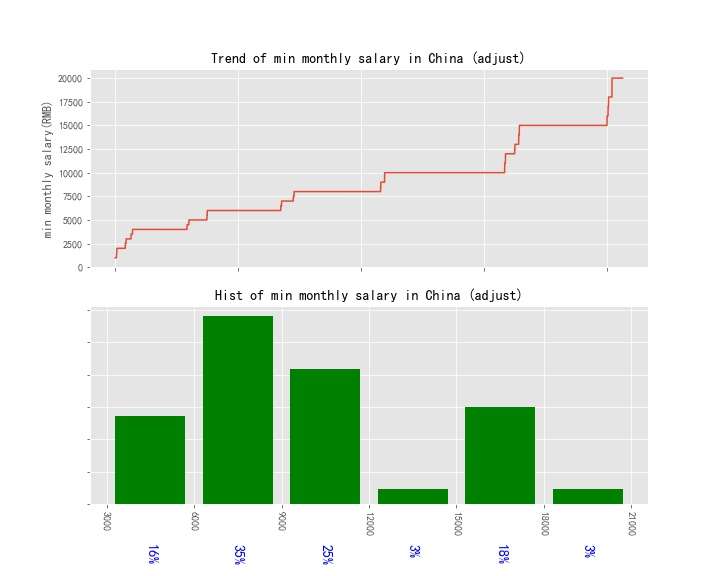
3.3 相关技能要求
brief_list = list(df_clean_concat['brief'])
brief_str = ''.join(brief_list)
print(type(brief_str))
# print(brief_str)
# with open('brief_quanguo.txt', 'w', encoding='utf-8') as f:
# f.write(brief_str)
<class 'str'>
对获取到的职位招聘要求进行词云图分析,代码如下:
# -*- coding: utf-8 -*-
"""
Created on Wed May 17 2017
@author: lemon
"""
import jieba
from wordcloud import WordCloud, ImageColorGenerator
import matplotlib.pyplot as plt
import os
import PIL.Image as Image
import numpy as np
with open('brief_quanguo.txt', 'rb') as f: # 读取文件内容
text = f.read()
f.close()
# 首先使用 jieba 中文分词工具进行分词
wordlist = jieba.cut(text, cut_all=False)
# cut_all, True为全模式,False为精确模式
wordlist_space_split = ' '.join(wordlist)
d = os.path.dirname(__file__)
alice_coloring = np.array(Image.open(os.path.join(d,'colors.png')))
my_wordcloud = WordCloud(background_color='#F0F8FF', max_words=100, mask=alice_coloring,
max_font_size=300, random_state=42).generate(wordlist_space_split)
image_colors = ImageColorGenerator(alice_coloring)
plt.show(my_wordcloud.recolor(color_func=image_colors))
plt.imshow(my_wordcloud) # 以图片的形式显示词云
plt.axis('off') # 关闭坐标轴
plt.show()
my_wordcloud.to_file(os.path.join(d, 'brief_quanguo_colors_cloud.png'))
得到结果如下:
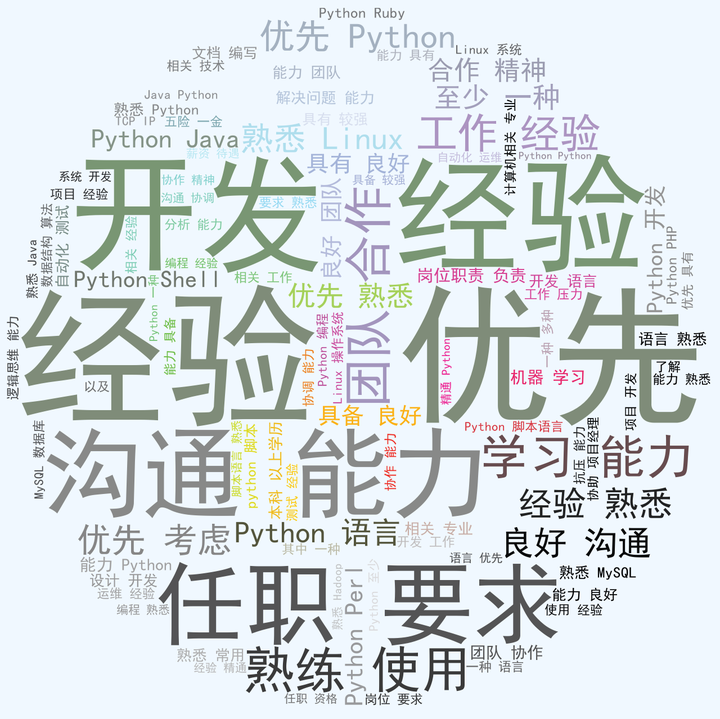
4 北京
4.1 月薪分布情况
df_beijing = df_clean_concat[df_clean_concat['gzdd'].str.contains('北京.*', regex=True)]
df_beijing.to_excel('zhilian_kw_python_bj.xlsx')
print('总行数为:{}行'.format(df_beijing.shape[0]))
# df_beijing.head()
总行数为:6936行
参考全国分析时的代码,月薪分布情况图如下:
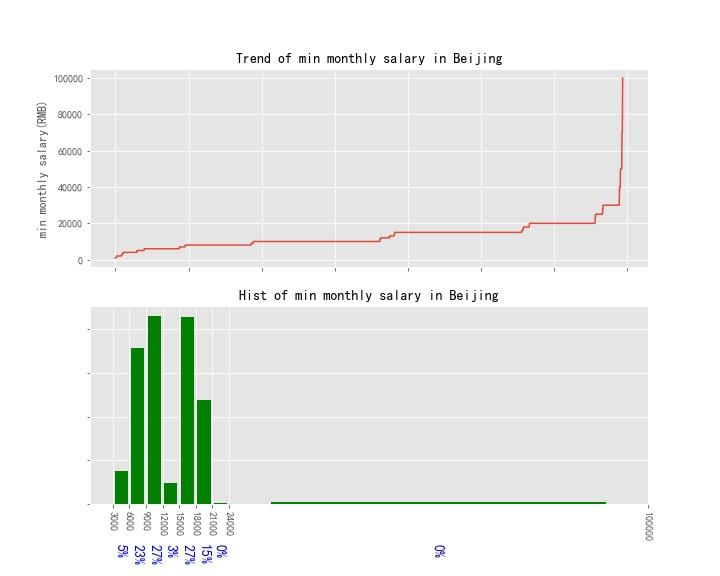
4.2 相关技能要求
brief_list_bj = list(df_beijing['brief'])
brief_str_bj = ''.join(brief_list_bj)
print(type(brief_str_bj))
# print(brief_str_bj)
# with open('brief_beijing.txt', 'w', encoding='utf-8') as f:
# f.write(brief_str_bj)
<class 'str'>
词云图如下:
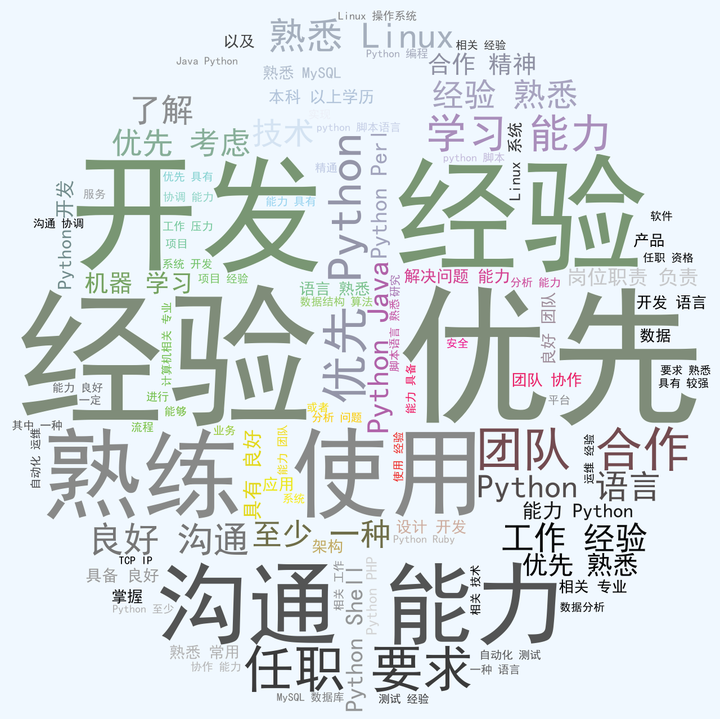
5 长沙
5.1 月薪分布情况
df_changsha = df_clean_concat[df_clean_concat['gzdd'].str.contains('长沙.*', regex=True)]
# df_changsha = pd.DataFrame(df_changsha, ignore_index=True)
df_changsha.to_excel('zhilian_kw_python_cs.xlsx')
print('总行数为:{}行'.format(df_changsha.shape[0]))
# df_changsha.tail()
总行数为:280行
参考全国分析时的代码,月薪分布情况图如下:
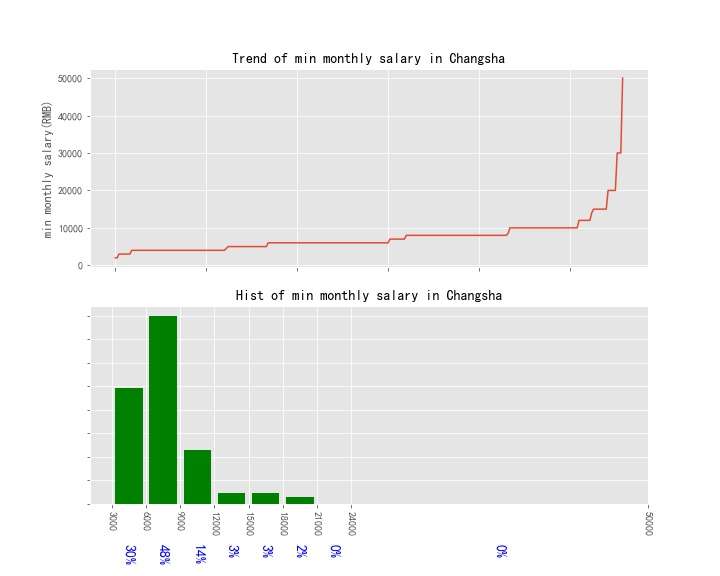
5.2 相关技能要求
brief_list_cs = list(df_changsha['brief'])
brief_str_cs = ''.join(brief_list_cs)
print(type(brief_str_cs))
# print(brief_str_cs)
# with open('brief_changsha.txt', 'w', encoding='utf-8') as f:
# f.write(brief_str_cs)
<class 'str'>
词云图如下:
